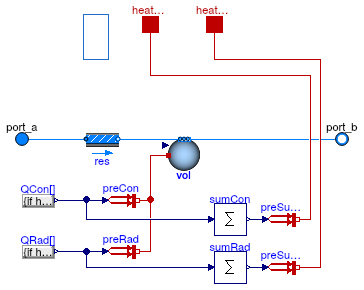Buildings.Fluid.HeatExchangers.Radiators
Package with radiators models for hydronic space heating systems
Information
This package contains models for radiators that are typically found in hydronic heating systems.Extends from Modelica.Icons.VariantsPackage (Icon for package containing variants).
Package Content
| Name | Description |
|---|---|
| Dynamic radiator for space heating | |
| Collection of models that illustrate model use and test models |
 Buildings.Fluid.HeatExchangers.Radiators.RadiatorEN442_2
Buildings.Fluid.HeatExchangers.Radiators.RadiatorEN442_2
Dynamic radiator for space heating

Information
This is a model of a radiator that can be used as a dynamic or steady-state model. The required parameters are data that are typically available from manufacturers that follow the European Norm EN 442-2.
However, to allow for varying mass flow rates, the transferred heat is computed using a discretization along the water flow path, and heat is exchanged between each compartment and a uniform room air and radiation temperature. This discretization is different from the computation in EN 442-2, which may yield water outlet temperatures that are below the room temperature at low mass flow rates. Furthermore, rather than using only one room temperature, this model uses a room air and room radiation temperature.
The transferred heat is modeled as follows: Let N denote the number of elements used to discretize the radiator model. For each element i ∈ {1, … , N}, the convective and radiative heat transfer Qic and Qir from the radiator to the room is
Qic = sign(Ti-Ta)
(1-fr) UA ⁄ N |Ti-Ta|n
Qir = sign(Ti-Tr)
fr UA ⁄ N |Ti-Tr|n
where Ti is the water temperature of the element, Ta is the temperature of the room air, Tr is the radiative temperature, 0 < fr < 1 is the fraction of radiant to total heat transfer, UA is the UA-value of the radiator, and n is an exponent for the heat transfer. The model computes the UA-value by numerically solving the above equations for given nominal heating power, nominal temperatures, fraction radiant to total heat transfer and exponent for heat transfer.
The parameter energyDynamics (in the Assumptions tab),
determines whether the model computes the dynamic or the steady-state response.
For the transient response, heat storage is computed using a
finite volume approach for the
water and the metal mass, which are both assumed to be at the same
temperature.
The default parameters for the heat capacities are valid for a flat plate radiator without fins, with one plate of water carying fluid, and a height of 0.42 meters.
Extends from Buildings.Fluid.Interfaces.PartialTwoPortInterface (Partial model transporting fluid between two ports without storing mass or energy), Buildings.Fluid.Interfaces.LumpedVolumeDeclarations (Declarations for lumped volumes).
Parameters
| Type | Name | Default | Description |
|---|---|---|---|
| replaceable package Medium | PartialMedium | Medium in the component | |
| Integer | nEle | 5 | Number of elements used in the discretization |
| Real | fraRad | 0.35 | Fraction radiant heat transfer |
| Real | n | 1.24 | Exponent for heat transfer |
| Nominal condition | |||
| MassFlowRate | m_flow_nominal | abs(Q_flow_nominal/cp_nomina... | Nominal mass flow rate [kg/s] |
| Power | Q_flow_nominal | Nominal heating power (positive for heating) [W] | |
| Temperature | T_a_nominal | Water inlet temperature at nominal condition [K] | |
| Temperature | T_b_nominal | Water outlet temperature at nominal condition [K] | |
| Temperature | TAir_nominal | 293.15 | Air temperature at nominal condition [K] |
| Temperature | TRad_nominal | TAir_nominal | Radiative temperature at nominal condition [K] |
| PressureDifference | dp_nominal | 0 | Pressure drop at nominal mass flow rate [Pa] |
| Transition to laminar | |||
| Real | deltaM | 0.3 | Fraction of nominal mass flow rate where transition to turbulent occurs |
| Assumptions | |||
| Boolean | allowFlowReversal | true | = false to simplify equations, assuming, but not enforcing, no flow reversal |
| Advanced | |||
| MassFlowRate | m_flow_small | 1E-4*abs(m_flow_nominal) | Small mass flow rate for regularization of zero flow [kg/s] |
| Boolean | from_dp | false | = true, use m_flow = f(dp) else dp = f(m_flow) |
| Boolean | linearized | false | = true, use linear relation between m_flow and dp for any flow rate |
| Diagnostics | |||
| Boolean | show_T | true | = true, if actual temperature at port is computed |
| Dynamics | |||
| Equations | |||
| Dynamics | energyDynamics | Modelica.Fluid.Types.Dynamic... | Type of energy balance: dynamic (3 initialization options) or steady state |
| Dynamics | massDynamics | energyDynamics | Type of mass balance: dynamic (3 initialization options) or steady state |
| Real | mSenFac | 1 + 500*mDry/(VWat*cp_nomina... | Factor for scaling the sensible thermal mass of the volume |
| Volume | VWat | 5.8E-6*abs(Q_flow_nominal) | Water volume of radiator [m3] |
| Mass | mDry | 0.0263*abs(Q_flow_nominal) | Dry mass of radiator that will be lumped to water heat capacity [kg] |
| Initialization | |||
| AbsolutePressure | p_start | Medium.p_default | Start value of pressure [Pa] |
| Temperature | T_start | Medium.T_default | Start value of temperature [K] |
| MassFraction | X_start[Medium.nX] | Medium.X_default | Start value of mass fractions m_i/m [kg/kg] |
| ExtraProperty | C_start[Medium.nC] | fill(0, Medium.nC) | Start value of trace substances |
| ExtraProperty | C_nominal[Medium.nC] | fill(1E-2, Medium.nC) | Nominal value of trace substances. (Set to typical order of magnitude.) |
Connectors
| Type | Name | Description |
|---|---|---|
| FluidPort_a | port_a | Fluid connector a (positive design flow direction is from port_a to port_b) |
| FluidPort_b | port_b | Fluid connector b (positive design flow direction is from port_a to port_b) |
| HeatPort_a | heatPortCon | Heat port for convective heat transfer with room air temperature |
| HeatPort_a | heatPortRad | Heat port for radiative heat transfer with room radiation temperature |
